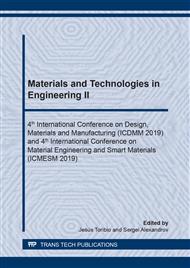p.50
p.55
p.61
p.71
p.78
p.86
p.93
p.102
p.109
Design of a Thin Metal Product with the Developable Middle Surface from a Sheet by Parabolic Bending
Abstract:
In the paper, the method to calculate the bending moments arising due to the process of parabolic bending of a thin metal sheet into a torso shell is offered. The problem is solved with the help of methods of differential geometry and shell theory. The possibility of manufacturing any torso product without creases and tears from a thin sheet made of plastic materials is theoretically proved. A review of experimental and theoretical works on pure bending is given. In contradistinction to the mathematical approach to bending a thin sheet into a torso shell (where the thickness of a sheet is assumed to be zero), this paper considers a technical approach taking into account the sheet thickness. It is shown that the normal stresses occurring in a thin sheet as a result of the bending can reach the yield point. On the contrary mathematical possibility to bend a sheet into a torso product, and then unbend it back into a flat position, it is shown in the paper that under certain conditions a sheet cannot be bent back to a flat sheet again due to the occurrence of plastic strains. The results of the research can be used in marine design, civil engineering, air-space industry, and other manufacturing processes.
Info:
Periodical:
Pages:
78-85
Citation:
Online since:
April 2020
Price:
Сopyright:
© 2020 Trans Tech Publications Ltd. All Rights Reserved
Share:
Citation:


